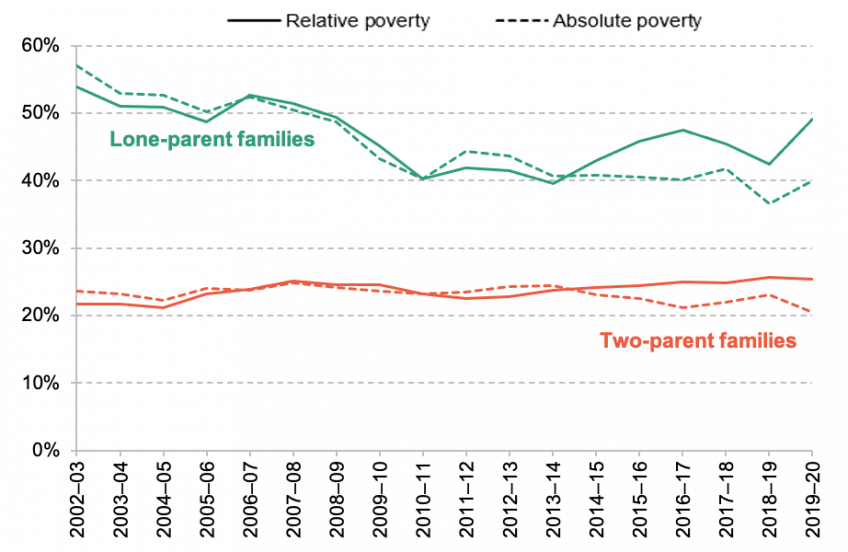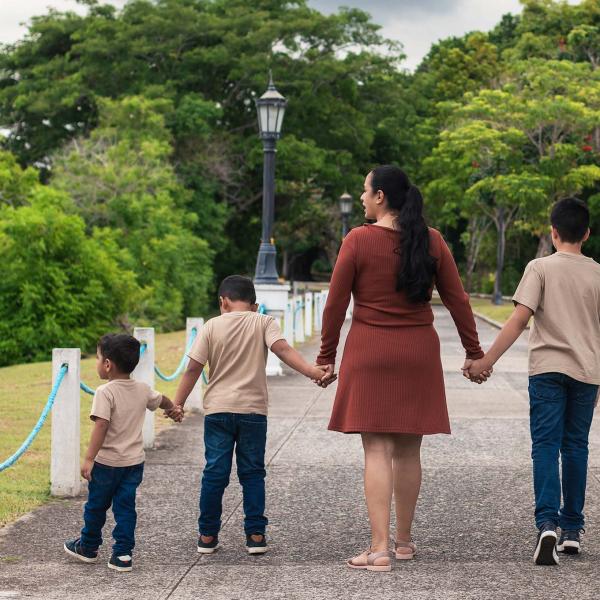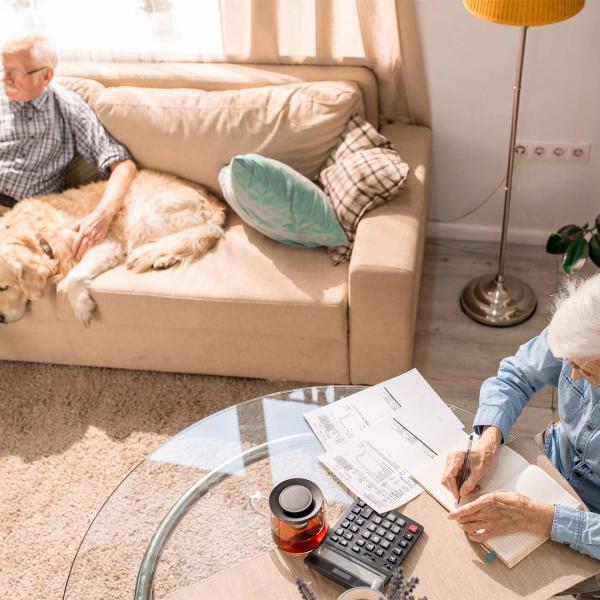In the year prior to the pandemic, nearly half (49%) of children in lone-parent families were in relative poverty – defined as having an income of less than 60% of median incomes adjusted for household size. This is almost double the rate among children living in two-parent families (25%). These are some of the early findings of research from IFS’s annual report into living standards, poverty and inequality, funded by the Joseph Rowntree Foundation, to be published in full on 14 July 2022.
During the pandemic, there were radical changes to the labour market, the furlough scheme was introduced, and there were large temporary increases in benefits, which temporarily pushed down poverty rates in 2020–21. But most of that support has now been withdrawn, meaning that poverty rates have likely rebounded since the pandemic. We therefore examine trends in child poverty that are not affected by the pandemic, using data up to 2019–20.
Figure 1 shows that relative poverty for children of lone parents rose by 9 percentage points between 2013–14 and 2019–20, from 40% to 49%. In contrast, relative poverty for children in two-parent families rose by only 2 percentage points over the same period. This implies that the incomes of lone parents fell further behind those on average incomes during the recovery from the Great Recession, and further behind the incomes of two-parent families. In 2019–20, 1.5 million children of lone parents were in relative income poverty. Children of lone parents accounted for around a fifth of all children (22%), but around a third of all children in relative poverty (36%).
In addition, there was no progress in reducing absolute poverty for children of lone parents in the years leading up to the pandemic. This is defined as children in households with incomes below a fixed poverty threshold, adjusted for inflation and household size, equivalent to around £14,400 per year for a lone parent with two young children in 2020–21. 40% of children in lone-parent families were in absolute poverty in 2019–20, essentially unchanged from 41% in 2013–14 – although considerably lower than before the Great Recession, when it was closer to 50%.
Figure 1. Relative (solid lines) and absolute (dashed lines) child poverty rates (measured after housing costs are deducted) in lone-parent and two-parent families, 2002–03 to 2019–20

Note: Incomes have been measured net of taxes and benefits. All incomes have been equivalised using the modified OECD equivalence scale.
Source: Authors’ calculations using the Family Resources Survey, 2002–03 to 2019–20.
The flatlining of absolute poverty and rise in relative poverty for children of lone parents reflect reductions in the real value of state benefits in the years from 2011 to 2019, as shown by Bourquin, Joyce and Norris Keiller (2020). Lone parents on low incomes are particularly reliant on income from benefits. These cuts to benefits have offset rises in employment incomes in recent years, which have been large for lone parents. The fraction of children living in a lone-parent family where their parent was working rose from 50% in 2007–08 to 54% in 2013–14 and reached 62% in 2019–20.
Looking further ahead, there has been widespread coverage of the increased rates of inflation in recent months. In response, the government has announced a large and progressive package of support for households, targeted at low-income households, while implementing tax rises on people with middle and high earnings. It is hard to know exactly how the combination of earnings growth, employment, and government policies to support households will affect the income distribution, but relative poverty rates are likely to fall, including for lone-parent families.
But it is important to note that some low-income families will benefit more than others from the government support for energy costs. In particular, the government’s decision to provide a flat rate of support to households on means-tested benefits, rather than uprating benefits in line with current inflation, means that the support provided is less generous (in percentage terms) for families currently receiving high levels of benefits.
Jonathan Cribb, Associate Director at IFS and an author of the report, said:
‘Rises in employment pushed up incomes of lone-parent families in the years running up to the pandemic, but cuts to state benefits and tax credits reduced their incomes. The combined effect was that there was no progress in reducing absolute poverty in lone-parent families between 2010 and 2019, and their incomes fell further behind those on average incomes.’











